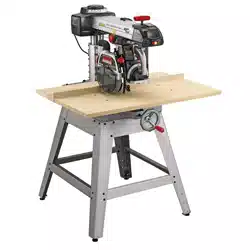Loading ...
Loading ...
Loading ...

basic saw operations
DADOING
Instructions for operating the Dado Head are contained in
booklet furnished with the Dado Head.
The saw arbor is designed for dado heads up to 13/16
inches wide. Do not install a wider dado head on the arbor.
Take several passes if required dado cut exceeds 13/16 inch.
When installing the dado head on the arbor, ALWAYS
install the inside "loose collar" first. Be sure the teeth of
the chippers are placed to fall in blade gullets, and chippers
are approximately equally spaced around the arbor.
DO NOT install the outside loose collar. Make sure the
arbor nut is tight. Install the arbor nut directly against the
outer blade of dado head.
For best results and to avoid excessive load on the motor,
NEVER CUT A 13/16" WIDE DADO, DEEPER THAN
3/4" IN ONE PASS.
MOLDING/SANDING
Instructions for operating the Molding Head are contained
in a booklet furnished with the Molding Head.
For use of Molding Head Cutter or Drum Sander with saw
arbor vertical the rear table requires an opening (next to
rear face of fence) for clearance. Cut this opening as shown.
REAR TABLE II_-[ -_F--I.h3" ]12-1/2"
_1 8--] J/2 I1_ l
For top-side rabbeting or molding in the in-rip position,
relieve the fence by positioning the cutting tool at the
desired location on the arm, locking the Carriage Lock
Knob, and lowering the cutting tool slowly into the fence -
remove only as much material from the fence as is
necessary.
NEVER USE A DADO HEAD OR MOLDING HEAD WITH THE SAW ARBOR VERTICAL WITHOUT INSTALLING AND
ADJUSTING A MOLDING HEAD/DADO GUARD. FOR TOP-SIDE DADOING OR MOLDING, INSTALL AND ADJUST
THE SAWBLADE GUARD AND ANTIKICKBACK ASSEMBLY FOR RIPPING OR CROSSCUTTING AS APPROPRIATE.
i
adjustments to compensate for wear
ADJUSTING BEVEL LOCK LEVER
1.
The purpose of this lever is to lock the motor at any
angle. To adjust, remove the set screw with wrench as
shown. Use the bevel lock lever as a wrench to tighten
the clamp bolt. Do Not Over Tighten. Replace bevel
lock lever in locked position and tighten the set screw.
NOTE: The clamp bolt has a left handed thread. Therefore,
to increase the clamping effect, rotate the bevel lock lever
- when used as a wrench - from right to left, or clockwise
when viewed from above. If you accidentally rotate it the
wrong way and disengage the bolt from the matching steel
nut, it will be necessary to remove the Handle Trim, Yoke
Handle, and Bevel Scale, in order to reinstall the bolt in the
nut.
YOKE LOCK HANDLE ADJUSTMENT.
1. This handle provides a friction lock between the upper
face of the yoke and the bottom face of the carriage.
It should eliminate any play or rotation between these
two parts when locked. Its proper position for saw
operation is approximately midway between the two
sides of the yoke.
When sufficient wear has occured to permit the handle
to move considerably to the rear, or strike the yoke
before locking, the handle must be adjusted as follows:
2. Remove arm cap trim and arm cap.
3. Remove carriage stop screw and Iockwasher with a 1/4
inch hex-L wrench.
4. Grasp the carriage assembly, move it carefully off the
end of radial arm, holding it parallel to the radial arm
until all carriage bearings are free of their tracks.
5. Rest the motor and carriage assembly on saw work
table and re-install carriage stop screw and Iockwasher.
CARRIAGE STOP
SCREW
ARM CAP
ARM CAP TRIM
\ /
HEX-I'Ll' WRENCH
(V4 .qCH)
28
Loading ...
Loading ...
Loading ...
